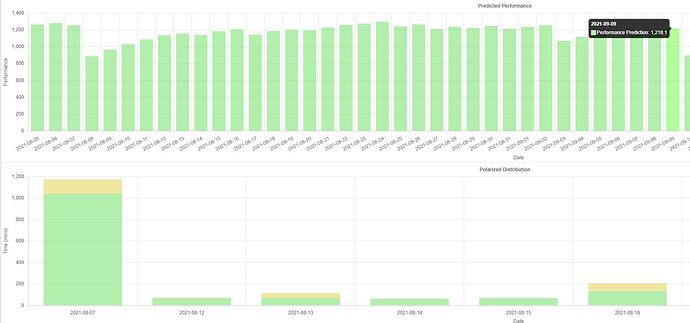Not quite sure where to put this, feel free to move.
I’ve been looking at the Polarized HR intensity distribution of my rides for the past 2 years. I’ve also implemented the Banister model, using TRIMP. It’s quite interesting when I zoom in on some of my ultra distance rides this year.
It’s quite interesting looking at the numbers. The ride was on a Saturday, started at midnight, and my ride time is 19 hours 40 minutes that day. I spent 17 hours 20 minutes in my Seiler Z1 / below LT1, and I spent 2 hours 40 mins in Seiler Z2. I didn’t spend any time in Seiler Z3 which is on purpose during such long events. I find any time in Z3 on such a long event causes a disproportionate impact on the rest of the ride, compared to the benefit.
You can see from my following ride data, that I then took 4 days off the bike. That is my pattern, in that I have one rest day for every 100km ridden. Then I return to the bike on August 12th with a 1 hour Seiler Z1 ride. The next day August 13th I include a little bit of Z2. This is also usual and it’s just see where the legs are. Then a couple of more days of 1 hour Seiler Z1 rides. Then 9 days after the event I do a 3.5 hour ride with with just over an hour of Seiler Z2. Then back to 1 hour Seiler Z1, and then 4 hours of Seiler Z1.
If you look at the top graph, which is the predicted performance via the Banister model you can see it shows the drop after the ultra. Then it predicts I would have got back to my previous performance by the 17th, had I not gone for the 4 hour ride on the 16th. It’s giving me a 10 days to recover previous performance if I don’t go mad in between. That is quite interesting as my minimum gap between ultra distance events of this length is two weeks or 14 days. I learnt from experience that trying them 7 days apart meant the second one didn’t go as well as I’d hope.
I haven’t tweaked the variables of the Banister model yet. I intend to do some standardised sub maximal tests once a month, and then reverse engineer them to fit the actual measured performance.
Anyway I thought it might be illuminating to some as to what ultra endurance cycling means in terms of hours on the bike, intensity distribution, and recovery. As a reminder I spend almost 20 hours riding my bike in a single 24 hour period. It’s not tough because of hard you go, it’s tough because of how long you go. From this you’ll realise why raising your LT1 HR / LT1 power is important for ultra distance. Together with legs that can endure these durations without muscle fatigue.
This is of course a n=1 sample.
Next August I’ll be riding a 1500km cycling event, with a time limit of 5 days. That is 5 back to back 300km days. Naturally you don’t fully recover day to day but it’s surprising what you can repeat day after day. For this repeatability I need a minimum of 3-4 hours sleep a day.
